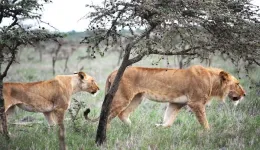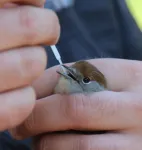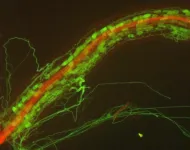(Press-News.org) The invasion of non-native species can sometimes lead to large and unexpected ecosystem shifts, as Douglas Kamaru and colleagues demonstrate in a unique, careful study that traces the links between big-headed ants, acacia trees, elephants, lions, zebras, and buffalo at a Kenyan conservancy. The invasive big-headed ant species disrupted a mutualism between native ants and the region’s thorny acacia trees, in which the native ants protected the trees from grazers in exchange for a place to live. Through a combination of observations, experimental plots, and animal tracking at Ol Pejeta Conservancy, Kamaru et al. followed the ecosystem chain reaction prompted by this disruption. When the invasive ants pushed out the native ants, the trees were left vulnerable to overgrazing by elephants, who browsed and broke trees at five to seven times the rate in areas with invasive ants compared to areas without the invaders. The result was a much more open landscape, where lions were left without hiding places to observe and stalk their preferred prey of zebra. Zebra kills were 2.87 times higher in uninvaded areas, compared to areas with the big-headed ants. The lions responded by shifting their prey to include more African buffalo. From 2003 to 2020, the proportion of zebra kills made by lions dropped from 67% to 42%, while the proportion of buffalo kills rose from 0% to 42%. The study offers an important glimpse at how disruption of a mutualism can have reverberations throughout an ecosystem, Kaitlyn Gaynor notes in a related Perspective. “Ultimately, the conservation of healthy ecosystems requires not only the prevention of species extinction but also the identification and preservation of the most important interactions between species,” Gaynor writes.
END
How an ant invasion led to lions eating fewer zebra in a Kenyan ecosystem
2024-01-25
ELSE PRESS RELEASES FROM THIS DATE:
Total organic carbon concentrations measured over Canadian oil sands reveal huge underestimate of emissions
2024-01-25
New measurements of total gaseous organic carbon concentrations in the air over the Athabasca oil sands in Canada suggest that traditional methods of estimating this pollution can severely underestimate emissions, according to an analysis by Megan He and colleagues. Using aircraft-based measurements, He et al. conclude that the total gaseous organic carbon emissions from oil sands operations exceed industry-reported values by 1900% to over 6300% across the studied facilities. “Measured facility-wide emissions represented approximately 1% of extracted petroleum, resulting in total organic ...
Machine learning model identifies waters protected under different interpretations of the U.S. Clean Water Act
2024-01-25
The U.S. Clean Water Act is a critically important part of federal water quality regulation, but the act does not define the exact waters that fall under its jurisdiction. Now, Simon Greenhill and colleagues have developed a machine learning model that helps to clarify which waters are protected from pollution under the United States’ Clean Water Act, and how recent rule changes affect protection. The model demonstrates that the waters protected under the act differ substantially depending on whether the act’s regulations follow a 2006 U.S. Supreme Court ruling or a 2020 White House rule. Under the 2006 Rapanos Supreme Court ruling, the model suggests that the Clean ...
Gamma ray observations of a microquasar demonstrate electron shock acceleration
2024-01-25
Observations of gamma rays, emitted by relativistic jets in a microquasar system, demonstrate the acceleration of electrons by a shock front, reports a new study. The microquasar SS 433 is a binary system made up of a compact object, probably a black hole, and a supergiant star. The black hole pulls material off the star and ejects plasma jets, which move at close to the speed of light. The High Energy Stereoscopic System (H.E.S.S.) is an array of five telescopes in Namibia that observe gamma rays. The H.E.S.S. ...
Astrophysical jet caught in a “speed trap”
2024-01-25
The science fiction author Arthur C. Clarke selected his own seven wonders of the world in a BBC television series in 1997. The only astronomical object he included was SS 433. It had attracted attention already in the late 1970s due to its X-ray emission and was later discovered to be at the center of a gas nebula that is dubbed the manatee nebula due to its unique shape resembling these aquatic mammals.
SS 433 is a binary star system in which a black hole, with a mass approximately ten times that of the Sun, and a star, with a similar mass but occupying a much larger volume, orbit each other with ...
Experts call for major shift in international decision-making to tackle ‘devastating’ impact of urban expansion and avoid ‘planetary catastrophe’
2024-01-25
Leading scientists are today calling for an urgent step change in global governance to save the future of worldwide cities and the planet at large.
Cities are growing at an unprecedented rate, putting overwhelming pressures on exploited land, scarce resources, and fragile ecosystems. The bold proposals, led by experts from the Universities of Bristol, Oxford and Yale, are set out in a Science journal article, proposing a new global advisory system to address the alarming impacts of urban expansion. This system would fulfil a similar function as the Intergovernmental ...
Teaching nature to break man-made chemical bonds
2024-01-25
For the first time, scientists have engineered an enzyme that can break stubborn man-made bonds between silicon and carbon that exist in widely used chemicals known as siloxanes, or silicones. The discovery is a first step toward rendering the chemicals, which can linger in the environment, biodegradable.
"Nature is an amazing chemist, and her repertoire now includes breaking bonds in siloxanes previously thought to evade attack by living organisms," says Frances Arnold, the Linus Pauling Professor of Chemical Engineering, Bioengineering and Biochemistry at Caltech and winner of the 2018 Nobel ...
Tiny ant species disrupts lion’s hunting behavior
2024-01-25
What makes the little old ant think he can disrupt the life of an African lion?
Researchers say it’s more than just high hopes.
In a study published today in the journal Science, a team of scientists reports that a tiny and seemingly innocuous invasive ant species is changing tree cover in an East African wildlife area, making it harder for lions, the world’s most iconic predator, to hunt its preferred prey, zebra.
“These tiny invaders are cryptically pulling on the ties that bind an African ecosystem together, determining who is eaten and ...
West Nile virus emergence and spread in Europe found to be positively associated with agricultural activities
2024-01-25
The spread of West Nile virus in Europe is strongly linked to agricultural activities, urbanization, and bird migration, according to a modelling study published January 25, 2024 in the open-access journal PLOS Pathogens by Lu Lu from the University of Edinburgh, UK, and collaborators belonging to a large European collaborative consortium under the VEO (Versatile Emerging infectious disease Observatory) project.
West Nile virus outbreaks have occurred in birds (the natural hosts and reservoirs for the virus), livestock, and ...
The underground network: Decoding the dynamics of plant-fungal symbiosis
2024-01-25
The intricate dance of nature often unfolds in mysterious ways, hidden from the naked eye. At the heart of this enigmatic tango lies a vital partnership: the symbiosis between plants and a type of fungi known as arbuscular mycorrhizal (AM) fungi. New groundbreaking research, recently published in the journal Science, delves into this partnership, revealing key insights that deepen our understanding of plant-AM fungi interactions and could lead to advances in sustainable agriculture.
AM fungi live within plant root cells, forming a unique alliance with ...
Jennifer Lippincott-Schwartz receives the Dickson Prize in Science
2024-01-25
Jennifer Lippincott-Schwartz, a senior group leader at HHMI's Janelia Research Campus and head of Janelia’s 4D Cellular Physiology research area, has been awarded the 2023 Dickson Prize in Science from Carnegie Mellon University for her pioneering work in live-cell imaging and organelle dynamics.
The Dickson Prize in Science recognizes substantial achievements or sustained progress in the fields of the natural sciences, engineering, computer science, or mathematics. It has been awarded annually since 1970.
Lippincott-Schwartz was recognized for her decades of work in cell biology, including the development of groundbreaking ...





